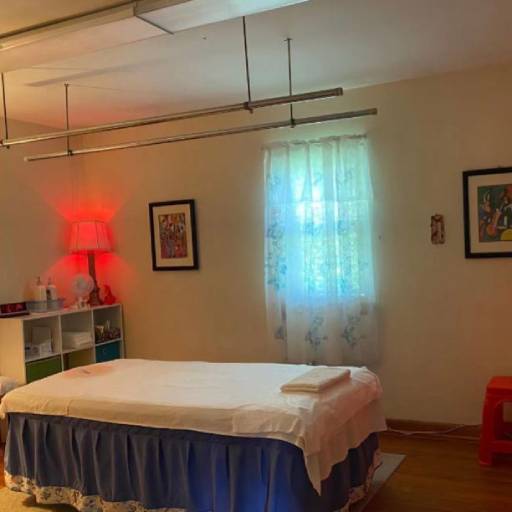Have you ever wondered why your masseuse seems to know exactly where to press and how to work their magic? Well, it all comes down to the fascinating world of massage rub maps. These maps are like treasure charts for relaxation, guiding therapists to the sweet spots that can melt away tension and stress in an instant. Whether you're a massage enthusiast or just curious about how these techniques work, understanding massage rub maps can transform your relaxation game forever.
Massage rub maps are not just random diagrams; they're carefully crafted blueprints that highlight key pressure points, muscle groups, and trigger zones across the body. These maps are used by professional therapists to deliver targeted treatments that go beyond surface-level relaxation. But here's the kicker—anyone can learn the basics and apply them for personal wellness or to help a loved one unwind.
What makes massage rub maps so intriguing is their ability to connect the dots between physical tension and emotional well-being. By targeting specific areas, you can release pent-up stress, improve circulation, and even alleviate chronic pain. So, if you're ready to dive into the world of therapeutic touch, let's explore how massage rub maps can become your ultimate relaxation tool.
Read also:Trudie Styler Before And After Plastic Surgery Ndash The Untold Story
What Exactly Are Massage Rub Maps?
Massage rub maps are visual representations of the body's pressure points, muscle groups, and nerve pathways. These maps serve as guides for therapists and enthusiasts alike, helping them identify areas that require special attention during a massage session. Think of them as roadmaps for relaxation, ensuring that every stroke and knead hits the right spot.
These maps are especially useful for targeting common trouble areas like the neck, shoulders, lower back, and feet. By understanding the layout of these maps, you can tailor your massage techniques to address specific needs, whether it's relieving muscle soreness after a workout or easing tension from a long day at the office.
How Massage Rub Maps Work
The science behind massage rub maps is rooted in anatomy and physiology. Each map highlights key areas where pressing, kneading, or rolling can have a profound impact on the body's natural healing processes. Here's how it works:
- Pressure Points: These are specific spots on the body that, when stimulated, can trigger relaxation or pain relief.
- Muscle Groups: Maps often outline major muscle groups, showing where tension tends to accumulate and how to release it.
- Nerve Pathways: By tracing nerve pathways, therapists can target areas that may be causing referred pain or discomfort.
In essence, massage rub maps are like cheat sheets for maximizing the benefits of a massage. They help ensure that every session is both effective and enjoyable.
Why Are Massage Rub Maps Important?
Understanding massage rub maps is crucial for anyone looking to enhance their massage experience. Whether you're a professional therapist or simply someone who enjoys giving massages to friends and family, these maps provide a structured approach to delivering results. Let's break it down:
First off, massage rub maps help you identify areas of tension and discomfort that might otherwise go unnoticed. For instance, a map might show you that the tension in your lower back could be linked to tightness in your hip flexors. Armed with this knowledge, you can focus your efforts on the root cause rather than just treating the symptoms.
Read also:Kiarapeach Legit Onlyfans Leaked The Untold Story Behind The Scenes
Additionally, these maps can improve the overall effectiveness of a massage. By following a structured approach, you ensure that no important areas are overlooked. This leads to a more comprehensive treatment that addresses the body as a whole, rather than just targeting isolated spots.
Common Misconceptions About Massage Rub Maps
There are a few myths floating around about massage rub maps that need to be addressed. For starters, some people believe that these maps are only useful for professionals. In reality, anyone can benefit from learning the basics. Another misconception is that all pressure points are the same for everyone. While there are general guidelines, individual differences mean that maps should be used as a starting point rather than a strict rulebook.
Lastly, some folks think that massage rub maps are only for therapeutic purposes. While they are certainly valuable in that context, they can also enhance recreational massages, making them more enjoyable and effective.
Creating Your Own Massage Rub Map
Want to create your own massage rub map? It's easier than you think! Start by identifying the areas of your body that tend to hold tension. Common spots include the neck, shoulders, lower back, and feet. Once you've pinpointed these areas, sketch them out on a basic diagram of the body.
Next, label each area with notes about the type of pressure or technique that works best for you. For example, you might find that deep tissue massage helps relieve tension in your lower back, while gentle strokes are more effective for your neck. Over time, you can refine your map based on what feels good and what delivers results.
Tools You'll Need
Creating a personalized massage rub map doesn't require fancy equipment. Here's what you'll need:
- A basic diagram of the human body (you can find printable templates online)
- A pen or marker for labeling
- A notebook for jotting down notes and observations
With these tools in hand, you're ready to start mapping out your path to relaxation. Remember, the goal is to create a map that works for you, so don't be afraid to experiment and adjust as needed.
Benefits of Using Massage Rub Maps
The benefits of using massage rub maps are numerous. For starters, they can enhance the effectiveness of your massage sessions by ensuring that you target the right areas. This leads to faster relief from tension and pain, as well as improved circulation and flexibility.
Another advantage is the ability to customize your massage experience. Whether you're dealing with a specific injury or just looking to unwind after a long week, a well-crafted massage rub map can help you tailor your session to your unique needs.
Emotional and Mental Benefits
Massage rub maps aren't just about physical benefits; they can also have a profound impact on your emotional and mental well-being. By targeting key pressure points, you can release endorphins, the body's natural mood boosters. This can help reduce stress, anxiety, and even symptoms of depression.
Moreover, the act of creating and using a massage rub map can be a meditative experience in itself. It encourages mindfulness and self-awareness, helping you tune into your body's needs and signals.
Types of Massage Techniques Using Rub Maps
Not all massage techniques are created equal, and different approaches work better for different areas of the body. Here's a breakdown of some popular techniques that can be enhanced with the help of massage rub maps:
Swedish Massage
Swedish massage is all about long, flowing strokes and gentle kneading. Using a massage rub map, you can identify areas where these techniques will be most effective, such as the back and shoulders.
Deep Tissue Massage
Deep tissue massage focuses on releasing deep-seated tension in the muscles and connective tissues. Maps can help you locate the specific areas that require this type of treatment, such as the lower back and hips.
Reflexology
Reflexology involves applying pressure to specific points on the feet, hands, and ears. Massage rub maps can guide you to these points, helping you deliver targeted treatments that promote overall well-being.
How to Use Massage Rub Maps for Self-Massage
Self-massage might sound tricky, but with the help of a massage rub map, it can be a breeze. Start by identifying the areas you want to target, then use tools like foam rollers, massage balls, or even your own hands to apply pressure and work out knots.
For example, if your map shows that tension in your neck is linked to tightness in your upper back, you can use a foam roller to target those areas while sitting comfortably on the floor. With a little practice, you'll be able to deliver professional-quality massages to yourself in no time.
Choosing the Right Massage Rub Map for You
With so many massage rub maps available, how do you choose the right one? Start by considering your specific needs and goals. Are you looking to relieve chronic pain, reduce stress, or improve flexibility? Different maps are designed to address different issues, so it's important to find one that aligns with your objectives.
Additionally, think about your level of experience. If you're new to massage techniques, you might want to start with a basic map that highlights the most common pressure points. As you become more comfortable, you can explore more advanced maps that delve into specific muscle groups and nerve pathways.
Where to Find Reliable Maps
When it comes to finding reliable massage rub maps, it's important to stick with trusted sources. Look for maps that are backed by scientific research and developed by certified therapists. Websites like the American Massage Therapy Association and the International Association of Structural Integration are great places to start.
Conclusion: Your Path to Ultimate Relaxation
In conclusion, massage rub maps are powerful tools that can transform your massage experience. By understanding how these maps work and learning to use them effectively, you can unlock a world of relaxation and well-being. Whether you're a professional therapist or simply someone who enjoys giving massages, these maps can help you deliver results that truly matter.
So, what are you waiting for? Grab a map, roll up your sleeves, and start exploring the wonders of therapeutic touch. And don't forget to share your newfound knowledge with others—after all, relaxation is best enjoyed when it's shared!
Table of Contents
- What Exactly Are Massage Rub Maps?
- Why Are Massage Rub Maps Important?
- Creating Your Own Massage Rub Map
- Benefits of Using Massage Rub Maps
- Types of Massage Techniques Using Rub Maps
- How to Use Massage Rub Maps for Self-Massage
- Choosing the Right Massage Rub Map for You
- Conclusion: Your Path to Ultimate Relaxation



